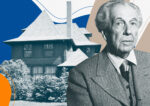A historic Frank Lloyd Wright-designed house in Chicago’s Austin neighborhood is deteriorating amid foreclosure complications, creating an urgent need to rescue it.
Built in 1903, the landmark J.J. Walser Jr. House at 42 North Central Avenue is plagued by roof holes, rotting window frames and multiple holes in the exterior plaster, including around the foundation, Crain’s reported, citing photos from the Frank Lloyd Wright Building Conservancy.
Barbara Gordon, the conservancy’s executive director, estimates restoration costs at about $500,000.
Last month, a decaying Wright row house in East Garfield Park was saved by a buyer. For the Walser house, however, unclear ownership makes a rescue challenging.
Johnny Teague, whose parents purchased the house in 1969, said that a $189,000 reverse mortgage his mother took out in 1997 has been problematic since her death in 2019. The reverse mortgage, which allows homeowners over 62 to access home equity without monthly payments, has accumulated interest, potentially surpassing the home’s market value.
Public records reveal a convoluted history of mortgage lenders. In May, the Federal National Mortgage Association assigned the reverse mortgage to Florida-based PHH Mortgage. A year earlier, the Bank of New York Mellon Trust initiated foreclosure proceedings.
The house, stuck in foreclosure limbo and deteriorating, has prompted groups like the conservancy to explore options, but legal complexities are stalling any concrete actions.
Darnell Shields, executive director of community revitalization group Austin Coming Together, stressed the urgency of securing the house to prevent further damage and potential hazards. His group envisions the Walser House as part of a revitalized Central Avenue corridor, alongside the Aspire Center and other nearby institutions.
Teague said the house has been unoccupied since his mother’s death. The Cook County treasurer still lists the property tax bill recipient as his deceased mother.
Despite financial struggles, the Teague family has been praised for their stewardship of the house, which serves as an integral part of Chicago’s architectural history.
“It was one of his best design experiments in inexpensive residences, and the first of a series of cross-axial houses for narrow suburban lots,” Gordon told the outlet.
—Quinn Donoghue
Read more



